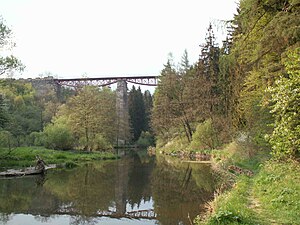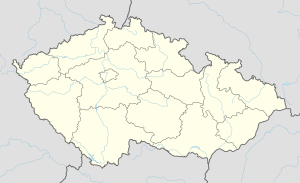Viaduct at Chrást
Coordinates: 49 ° 48 ′ 11 ″ N , 13 ° 30 ′ 20 ″ E
| Viaduct at Chrást | ||
|---|---|---|
| Viaduct at Chrást | ||
| Convicted | Chrást u Plzně – Stupno railway line | |
| Crossing of | Klabava | |
| place | Chrást u Plzně | |
| overall length | 105 m | |
| Number of openings | three | |
| opening | 1863 | |
| location | ||
|
|
||
The viaduct near Chrást was built 700 m away from the Chrást u Plzně zastávka stop for the transfer of the Chrást u Plzně – Stupno railway across the Klabava valley . The bridge was commissioned in 1862 and is still used for rail traffic.
Technical specifications
The bridge consists of two outer bridgeheads and two pillars over which three trusses lead.
The height of the bridge is 25.7 m, the total length 105 m.
history
Rudolf Schifkorn developed a new bridge construction system in Austria in 1853, in which the wooden Howe trusses were made entirely of iron. The parts exposed to pressure loads, so the upper belt and the inclined struts in which artificial overpressure generated by the vertical tie rods always, he exhibited cast iron forth while he for the drawn chord wrought iron flat bars and also for the tension rods wrought iron took . Schifkorn put the top chord together from individual pieces reaching from knot to knot, which were held together by means of continuous longitudinal rails tensioned on the end posts. The struts were also composed of individual pieces, so that with high girders and multiple networks they consisted of up to four parts, which were fixed by two wrought iron bands. The main girders of each bridge were two to four walls placed side by side, connected to one another and constructed in the same way.
The Schifkorn bridge system was greeted enthusiastically when it appeared. They praised the advantage of these bridges, which, in contrast to the lattice bridges emerging at the time, did not require rivets. But there was no shortage of opponents, in particular Karl Ritter von Hornbostel and Wilhelm Pressel , who opposed the construction with a very cool, objective criticism.
The composition of the beams from many parts and their inadequate connection, the indeterminacy that was brought into the operation of the links by the artificial tensions, the use of unreliable cast iron and its combination with wrought iron, i.e. the connection of materials with unequal elasticity ratios , were quickly identified as weak points in the new carrier. When, during the bridge disaster near Czernowitz on March 4, 1868, a 37 m wide bridge span of the Pruth Bridge collapsed under a mixed freight and passenger train, the design flaws became obvious. The Schiffkorn girders in more than 150 railway bridges were then replaced by the now recognized riveted truss bridges .

It was not until 1892 that the girders of the viaduct in Chrást were exchanged for fish belly girders . Shortly afterwards, in 1894, the last Schifkorn railway bridge, the Elbe bridge of the Bohemian Northern Railway near Tetschen , was replaced by a modern construction.
The bridge was renovated again between 2002 and 2003 and reopened in 2003.
Individual evidence
- ↑ Joseph Dušan: Encyklopedie mostů v Čechách, na Moravě a ve Slezsku. Libri, 2002. p. 553. Dostupné online. ISBN 80-7277-095-0 .
- ↑ Technické památky v Čechách, na Moravě a ve Slezsku / kolektiv autorů pod vedením hlavní editorky Hany Hlušičkové. Libri, Prague, 2001-2004. ISBN 80-7277-045-4 .
- ↑ a b c d Josef Zuffer: Bridge building. In: Dr. Leon Ritter v. Bilinski. Emil Ritter v. Guttenberg, Wilhelm Ast, Franz Bauer, Alfred Birk, Theodor Bock, Karl Gölsdorf, Franz Mähling, Josef Schlüsselberger and Hermann Strach (eds.): History of the railways of the Austrian-Hungarian monarchy. II. Volume. Vienna, Teschen, Leipzig. Karl Prochaska. KUK Hofbuchhandlung & k. UK court printing company. MDCCCXCVIII (1898). Pp. 281 and 285-286.

